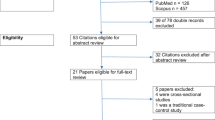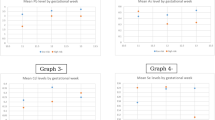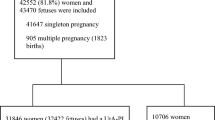Abstract
This study aims to delineate the levels of Cd exposure in maternal blood, placenta, and cord blood, and to explore the association between Cd levels and the risk of preeclampsia (PE), as well as its potential impact on fetal growth among affected individuals. A case-control study was performed at the First Hospital of Shanxi Medical University, involving 373 pregnant women diagnosed with PE and 485 controls. Cd was measured in maternal blood, placenta, and cord blood using ICP-MS. The association between Cd and birth weight z-score was analyzed by multivariate linear regression. Logistic regression analysis was used to investigate the relationships between Cd and the risk of PE, and Cd and the risk of fetal growth. The concentration of Cd in the placenta was higher than that in maternal blood and cord blood. The highest tertile of placental Cd was identified as a risk factor for PE (OR = 2.704, 95% CI: 1.865, 3.921). Among pregnant women with PE, higher levels of Cd exposure in the placenta were negatively associated with birth weight z-scores (per doubling: β = −0.134, 95% CI: −0.264, −0.004), and the highest tertile of placental Cd was associated with an elevated risk of SGA (OR = 2.103, 95% CI: 1.164, 3.801). Furthermore, an interaction between Cd and PE was identified. In conclusion, Cd can accumulate in the placenta of pregnant women, and high placental Cd exposure not only increases the risk of PE but also exacerbates the risk of SGA outcome in PE pregnant women.

This is a preview of subscription content, access via your institution
Access options
Subscribe to this journal
Receive 12 print issues and online access
$259.00 per year
only $21.58 per issue
Buy this article
- Purchase on SpringerLink
- Instant access to full article PDF
Prices may be subject to local taxes which are calculated during checkout


Similar content being viewed by others
References
Sakamoto M, Yasutake A, Domingo JL, Chan HM, Kubota M, Murata K. Relationships between trace element concentrations in chorionic tissue of placenta and umbilical cord tissue: potential use as indicators for prenatal exposure. Environ Int. 2013;60:106–11.
Geng HX, Wang L. Cadmium: toxic effects on placental and embryonic development. Environ Toxicol Pharm. 2019;67:102–7.
Xing Y, Xia W, Zhang B, Zhou A, Huang Z, Zhang H, et al. Relation between cadmium exposure and gestational diabetes mellitus. Environ Int. 2018;113:300–5.
Liu W, Zhang B, Huang Z, Pan X, Chen X, Hu C, et al. Cadmium body burden and gestational diabetes mellitus: a prospective study. Environ Health Perspect. 2018;126(2):027006.
Liu H, Xia W, Xu S, Zhang B, Lu B, Huang Z, et al. Cadmium body burden and pregnancy-induced hypertension. Int J Hyg Environ Health. 2018;221(2):246–51.
Liu T, Zhang M, Guallar E, Wang G, Hong X, Wang X, et al. Trace minerals, heavy metals, and preeclampsia: findings from the Boston Birth Cohort. J Am Heart Assoc. 2019;8(16):e012436.
Ovayolu A, Turksoy VA, Gun I, Karaman E, Dogan I, Turgut A. Analyses of maternal plasma cadmium, lead, and vanadium levels in the diagnosis and severity of late-onset preeclampsia: a prospective and comparative study. J Matern Fetal Neonatal Med. 2022;35(24):4803–9.
Laine JE, Ray P, Bodnar W, Cable PH, Boggess K, Offenbacher S, et al. Placental cadmium levels are associated with increased preeclampsia risk. PLoS ONE. 2015;10(9):e0139341.
Al-Saleh I, Shinwari N, Mashhour A, Rabah A. Birth outcome measures and maternal exposure to heavy metals (lead, cadmium and mercury) in Saudi Arabian population. Int J Hyg Environ Health. 2014;217(2-3):205–18.
Thomas S, Arbuckle TE, Fisher M, Fraser WD, Ettinger A, King W. Metals exposure and risk of small-for-gestational age birth in a Canadian birth cohort: the MIREC study. Environ Res. 2015;140:430–9.
Habibian Sezavar A, Abyareh M, Fahimi R, Nyasulu PS, Abyadeh M. The association between maternal cadmium exposure and small for gestational age: a systematic review and meta-analysis. Int J Environ Health Res. 2022;32(7):1469–77.
Odegård RA, Vatten LJ, Nilsen ST, Salvesen KA, Austgulen R. Preeclampsia and fetal growth. Obstet Gynecol. 2000;96(6):950–5.
Faul F, Erdfelder E, Lang AG, Buchner A. G*Power 3: a flexible statistical power analysis program for the social, behavioral, and biomedical sciences. Behav Res Methods. 2007;39(2):175–91.
Faul F, Erdfelder E, Buchner A, Lang AG. Statistical power analyses using G*Power 3.1: tests for correlation and regression analyses. Behav Res Methods. 2009;41(4):1149–60.
Denning PW, Dai L, Deng C, Li Y, Zhu J, Mu Y, et al. Birth weight reference percentiles for Chinese. PLoS ONE. 2014;9:e104779.
Zhang T, Wang X, Luo Z-C, Liu J, Chen Y, Fan P, et al. Maternal blood concentrations of toxic metal(loid)s and trace elements from preconception to pregnancy and transplacental passage to fetuses. Ecotoxicol Environ Saf. 2023;264:115394.
Jukic AMZ, Zuchniak A, Qamar H, Ahmed T, Mahmud AA, Roth DE. Vitamin D treatment during pregnancy and maternal and neonatal cord blood metal concentrations at delivery: results of a randomized controlled trial in Bangladesh. Environ Health Perspect. 2020;128:117007.
Bocca B, Ruggieri F, Pino A, Rovira J, Calamandrei G, Martínez MÁ, et al. Human biomonitoring to evaluate exposure to toxic and essential trace elements during pregnancy. Part A. concentrations in maternal blood, urine and cord blood. Environ Res. 2019,177:108599.
Dong X, Ding A, Hu H, Xu F, Liu L, Wu M. Placental barrier on cadmium transfer from mother to fetus in related to pregnancy complications. Int J Womens Health. 2023;15:179–90.
Wang F, Fan FY, Wang LY, Ye W, Zhang Q, Xie SS. Maternal cadmium levels during pregnancy and the relationship with preeclampsia and fetal biometric parameters. Biol Trace Elem Res. 2018;186(2):322–9.
Luo Y, Zhang H, Gui F, Fang J, Lin H, Qiu D, et al. Concentrations and influencing factors of 17 elements in placenta, cord blood, and maternal blood of women from an e-waste recycling area. J Trace Elem Med Biol. 2024;84:127449.
Iwai-Shimada M, Kameo S, Nakai K, Yaginuma-Sakurai K, Tatsuta N, Kurokawa N, et al. Exposure profile of mercury, lead, cadmium, arsenic, antimony, copper, selenium and zinc in maternal blood, cord blood and placenta: the Tohoku Study of Child Development in Japan. Environ Health Prev Med. 2019;24:35.
Zhang Q, Huang Y, Zhang K, Huang Y, Yan Y, Wang F, et al. Cadmium-induced immune abnormality is a key pathogenic event in human and rat models of preeclampsia. Environ Pollut. 2016;218:770–82.
Zhang Q, Huang Y, Zhang K, Yan Y, Wu J, Wang F, et al. Progesterone attenuates hypertension and autoantibody levels to the angiotensin II type 1 receptor in response to elevated cadmium during pregnancy. Placenta. 2018;62:16–24.
Wang Y, Wang K, Han T, Zhang P, Chen X, Wu W, et al. Exposure to multiple metals and prevalence for preeclampsia in Taiyuan, China. Environ Int. 2020;145:106098.
Borghese MM, Fisher M, Ashley-Martin J, Fraser WD, Trottier H, Lanphear B, et al. Individual, independent, and joint associations of toxic metals and manganese on hypertensive disorders of pregnancy: results from the MIREC Canadian Pregnancy Cohort. Environ Health Perspect. 2023;131(4):47014.
Gustin K, Barman M, Stråvik M, Levi M, Englund-Ögge L, Murray F, et al. Low-level maternal exposure to cadmium, lead, and mercury and birth outcomes in a Swedish prospective birth-cohort. Environ Pollut. 2020;265(Pt B):114986.
Zhao S, Yang X, Xu Q, Li H, Su Y, Xu Q, et al. R: association of maternal metals exposure, metabolites and birth outcomes in newborns: a prospective cohort study. Environ Int. 2023;179:108183.
Esteban-Vasallo MD, Aragonés N, Pollan M, López-Abente G, Perez-Gomez B. Mercury, cadmium, and lead levels in human placenta: a systematic review. Environ Health Perspect. 2012;120(10):1369–77.
Pollack AZ, Ranasinghe S, Sjaarda LA, Mumford SL. Cadmium and reproductive health in women: a systematic review of the epidemiologic evidence. Curr Environ Health Rep. 2014;1(2):172–84.
Erboga M, Kanter M. Effect of cadmium on trophoblast cell proliferation and apoptosis in different gestation periods of rat placenta. Biol Trace Elem Res. 2016;169(2):285–93.
Xu L, Ge J, Huo X, Zhang Y, Lau ATY, Xu X. Differential proteomic expression of human placenta and fetal development following e-waste lead and cadmium exposure in utero. Sci Total Environ. 2016;550:1163–70.
Xu P, Wu Z, Xi Y, Wang L. Epigenetic regulation of placental glucose transporters mediates maternal cadmium-induced fetal growth restriction. Toxicology. 2016;372:34–41.
Wang H, Wang Y, Bo QL, Ji YL, Liu L, Hu YF, et al. Maternal cadmium exposure reduces placental zinc transport and induces fetal growth restriction in mice. Reprod Toxicol. 2016;63:174–82.
Gestational Hypertension and Preeclampsia. ACOG Practice Bulletin Summary, Number 222. Obstet Gynecol. 2020;135(6):1492–15.
Ganguly K, Levänen B, Palmberg L, Åkesson A, Lindén A. Cadmium in tobacco smokers: a neglected link to lung disease? Eur Respir Rev. 2018;27:170122.
Matt GE, Quintana PJE, Hoh E, Dodder NG, Mahabee-Gittens EM, Padilla S, et al. Tobacco smoke is a likely source of lead and cadmium in settled house dust. J Trace Elem Med Biol. 2021;63:126656.
Jung SY, Kim S, Lee K, Kim JY, Bae WK, Lee K, et al. Association between secondhand smoke exposure and blood lead and cadmium concentration in community dwelling women: the fifth Korea National Health and Nutrition Examination Survey (2010-2012). BMJ Open. 2015;5(7):e008218.
Acknowledgements
The authors express their appreciation to the participants in the Taiyuan Birth Cohort Study for their enthusiastic support.
Funding
This work was supported by the National Natural Science Foundation of China [grant number 82373677]; the Natural Science Foundation of Shanxi [grant number 202103021224229]; the Fund Program for the Scientific Activities of Selected Returned Overseas Professionals in Shanxi Province [grant number 20210042]; and the Research Project Supported by Shanxi Scholarship Council of China [grant number 2023-099].
Author information
Authors and Affiliations
Corresponding authors
Ethics declarations
Conflict of interest
The authors declare no competing interests.
Additional information
Publisher’s note Springer Nature remains neutral with regard to jurisdictional claims in published maps and institutional affiliations.
Supplementary information
Rights and permissions
Springer Nature or its licensor (e.g. a society or other partner) holds exclusive rights to this article under a publishing agreement with the author(s) or other rightsholder(s); author self-archiving of the accepted manuscript version of this article is solely governed by the terms of such publishing agreement and applicable law.
About this article
Cite this article
Wu, W., Zhang, B., Zhao, J. et al. Cadmium levels in maternal blood, placenta, and cord blood in relation to preeclampsia and fetal growth: a case-control study in China. Hypertens Res 48, 1321–1330 (2025). https://doi.org/10.1038/s41440-025-02122-1
Received:
Revised:
Accepted:
Published:
Issue date:
DOI: https://doi.org/10.1038/s41440-025-02122-1



